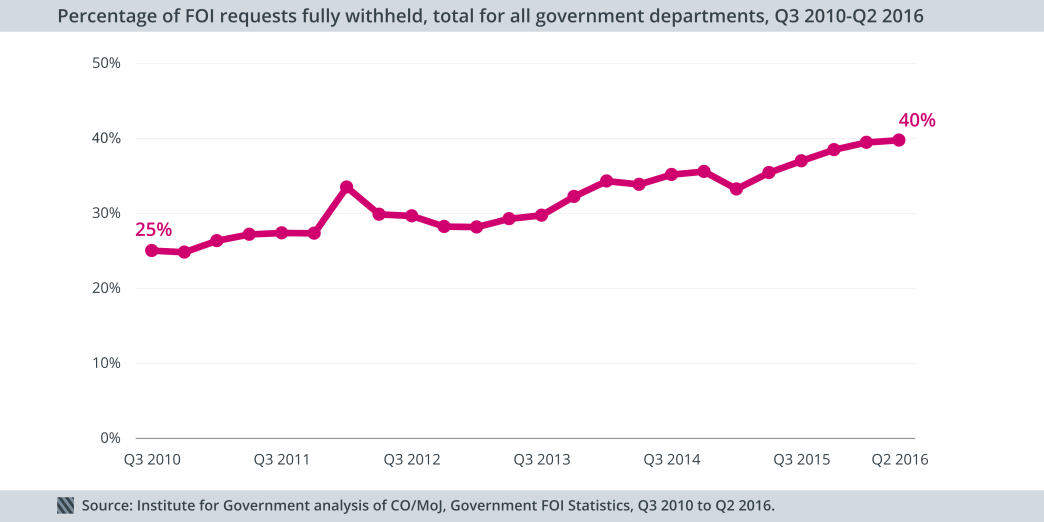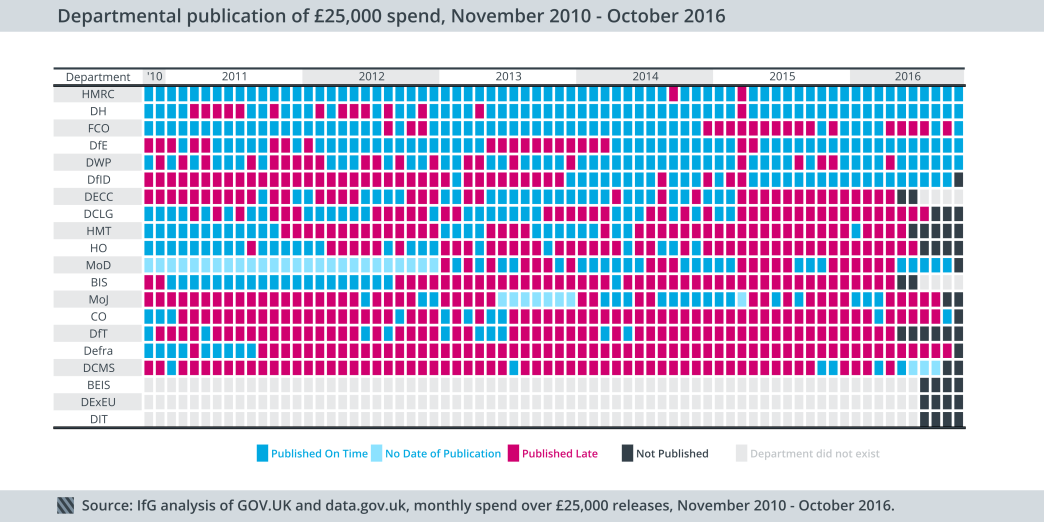The 2017 Whitehall Monitor report identifies a worrying backslide in government transparency. Adam Boon says this raises concerns about the Government’s commitment to open data and will make it harder to assess the performance of Whitehall unless this trend is reversed.
Chapter 7 in our annual Whitehall Monitor report focuses on the Government’s track record in communicating transparently. And its recent record is cause for concern. At the event to launch our report, Meg Hillier MP, Chair of the Public Accounts Committee, and Chris Cook, Policy Editor for BBC Newsnight, discussed claims that government transparency is decreasing.
Departments withheld more FoI requests in 2016, compared to 2010.

When departments receive Freedom of Information (FoI) requests, they can release the information in full, partially withhold it, or withhold in full. In the third quarter of 2010, government departments withheld information in full in response to 25% FoI requests. By the third quarter of 2016, that had risen to 40%.
Even when departments respond to requests, some are not meeting deadlines. In the most recent figures, seven departments – Scotland Office, Home Office, MoJ, DWP, BEIS, DExEU and DCLG – responded to less than 85% of FoI requests on time, which is below the threshold set by the Information Commissioner.
Hillier says these trends of withholding information and publishing it late show that ‘transparency is not embedded in the civil service.’
Departments are failing to publish information on spending over £25,000.

In 2010, then Prime Minister David Cameron wrote to departments telling them to be more transparent. This included publishing information on departmental spending over £25,000. Departments have increasingly stopped publishing this expenditure data completely and on time. Since the European Union referendum in June, DfT, HMT, HO and DCLG have failed to publish at least three months’ data on over £25,000 spend, and no monthly releases have yet been published for DExEU, DIT or BEIS (as of December 2016).
The panellists at our launch event agreed it is essential for accountability that the public can access and use the type of data Whitehall Monitor uses in its annual report. Decreases in the frequency of data publications emphasise the importance of having strong political support for a transparency agenda (previously provided by Francis Maude from 2010-2015) to maintain momentum. Progress on transparency is an effort at multiple levels of government: Hillier says that the Public Accounts Committee are concerned about how transparency at the local level will improve as more powers are devolved locally, so people know what their taxes are being spent on.
Issues around the quality of government data – for example, the dumping of incomprehensible and irreconcilable spreadsheets on government websites – doesn’t just apply to open data initiatives in recent years. Cook described social care statistics as ‘poor’ despite being an important area of public policy. In February the IfG will launch its new data-driven assessment of the scope and quality of public services (Performance Tracker), which includes an assessment of social care (and other public services) since 2010.
Cook wants people to be ‘more condemnatory’ of the Government’s approach to transparency. He argues that the civil service has ‘a policy of not being transparent’, and that the ‘Cabinet Office doesn’t meet their basic statutory obligations’. It’s unclear whether or not the data departments publish is the same as the information ministers are seeing internally and basing their decisions on.
In response to these concerning trends about transparency, Cook is calling on the Government Digital Service (GDS) to take on a ‘policing role’ and pressure departments across Whitehall to meet basic requirements on the use and publication of data. Hillier and Cook both argue that the role of Chief Data Officer needs to:
- ensure data across government is provided in a usable format
- bring in best practice from outside government and the public sector
- challenge permanent secretaries and ministers on the availability of data
- set clear standards for the use and format of data for all departments to work towards.
Whether it’s Parliament and civil society scrutinising departments’ performance, or government departments better understanding how they operate, the aim is the same: government that works better and is as transparent, effective and accountable as it can be.
Watch or listen to the full launch event or the audio slideshow.
Read the full report – Whitehall Monitor 2017: the civil service as it faces Brexit.
- Supporting document
- Whitehall monitor 17.pdf (PDF, 2.17 MB)